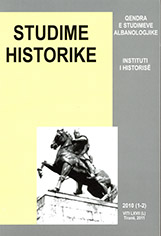Benda e Arbrit në Mesjetën e Vonë
Arbëria's Benda in the later Middle Ages
Author(s): Pëllumb XhufiSubject(s): History
Published by: Qendra e Studimeve Albanologjike
Keywords: Arbëria's Benda ; Middle Ages; Albania; Albanian History
Summary/Abstract: At the end of the 12th century, more evidently, but in fact since the 11th century, the byzantine sources in the beginning, followed a little later by the Papal and Slavic ones, start distinguishing a central territory of the medieval Albania, which they called Arber. (greek. Ἄλβανον, lat. Albanum, slav. Рабьнь). Due to its geographic position, close to Durrës and along the Egnatian Way, Arbër has been in the center of the medieval history, not only of Albania, but of the history of Adriatic - Balkans, as well. That is why famous scientists of Balkanology and Albanology have baptized Arbër as the "nucleus" of medieval Albania. In this territory, around the end of the 12th century, the Principality of Arbër, the first formation of an Albanian medieval government was created. During the 14th century, the land of Arbër, more or less integrated the lordship (county) of Topiaj, and in the 15th century it was unified with the stable center of the State of Skanderbeg. Even on 1621, one and a half century after Skanderbeg's death, a well-known habitant of these lands, Pjetër Gudi from Gurabardh, testifies that the territories once belonging to Arbër, were now called "the lands of Skanderbeg" by his compatriots. Thus were considered the cities of Mat, Benda, Kurbin, Tamadhë and Çermenikë, which are part of the highlands behind the cities of Krujë and Elbasan. This study aimes to throw light on one of the regions that belonged to Arbër, Benda. In that effort, the study tries to define the geographical position of Benda, as related to neighbor territories. It begins from Tomadhë, precisely identified in Martanesh, mentioned with that name in late sources. The author presents a new concept concerning the geographical location of the lands of Kunavi and Stefani as well. This concept confronts the locations given by authors like Sufflay or Stadtmüller. On the other hand, based on the unused documents and on a reconsideration of the historic documentation, it is proved that Benda is the place of origin of the famous family Shkurra. On an earlier study, the author has mentioned the thesis that the Princes of Arbër during the 12 th and 13th century, Dhimiitër, Gjon, Progon belonged to this family. The fact that, even during the 16th - 18th century, Benda remains a center for the political and military development, regarding to the resistance against the ottoman occupation, is another element brought by the author.
Journal: Studime Historike
- Issue Year: 2010
- Issue No: 01-02
- Page Range: 005-020
- Page Count: 16
- Language: Albanian
- Content File-PDF

